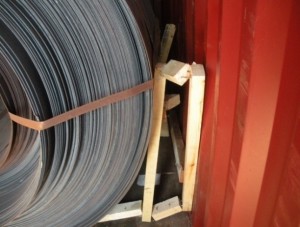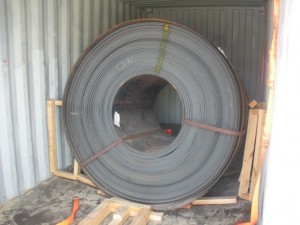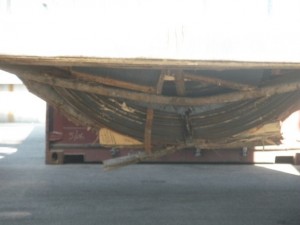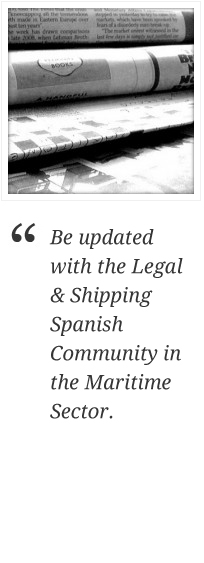Collapse of containers floors due to bad stowage and/or lashing of steel coils
Sedgwick Iberia | Calle MartÃnez Villergas 52 | 28027 | Madrid | PHONE +34 91 566 3210
Collapse of containers floors due to bad stowage and/or lashing of steel coils
This technical article aims to complete the information available regarding an issue we could verify in some of the inspections we’ve performed: the collapse of the floor of TEU’s containers when steel coils are shipped separately owing to their size. Single coils are frequently centered on the containers’ bottom, them being held down in good stowage and lashing conditions that permit the proper distribution of the cargo weight all over the container loading floor, as well as the adequate securing arrangements.
Commercial coils have a gross mass that varies between 4 and 26 tons. To this extent everything seems correct, as no coil appears to exceed the maximum load a container allows within. Different from this it is the specific maximum load permitted on the floor of such cargo transport unit, which is far exceeded by the stress exerted by the coil when this one is placed in the middle of the container. It should be pointed out that the problem originates when the arrangement of the coil over the container flooring is carried out in the manner ‘eye to side’ or ‘eye to rear’, while the stowage structure either it is not available, or it is not sufficiently resistant due to its structural type or to the improper lashing of the coil, which causes a shifting that collapses this structure. When this occurs, the securing system stops fulfilling the task assigned and so the coil rests directly over the container floor. Therefore, the supporting surface for the coil becomes an area of the size of the coiled steel sheet width multiplied by the length of the footprint on which is supported.
For instance, based on the assumption of a coil of 4 tons, with 1 metre width and a support length of 5 centimetres, the stress exerted by the coil in the middle of the container would reach 8kg/cm2. And in the case the coil was the largest of the commercial standard’s, this is, over 26 tonnes, the stress exerted over the container flooring would reach values near 52 kg/cm2.
It seems evident that containers are not designed to withstand that specific weight and, nonetheless, as the restriction of maximum load is not exceeded, the effort for a proper distribution of the weight of the cargo is disregarded. Then, at some point in time, when the stowage structure gets broken (due to its own structure or to the inadequate lashing of the coil), or directly is not available, the loading floor of the container cannot bear the strain exerted by the coil, ending up in a failure of the structure itself, and making its floor collapse. It is important to build stowage structures in such a way they are enhanced by longitudinal bottom side rails as the i-beams of the container flooring are close enough so as no cross members’ reinforcement is needed, regardless of the direction in which the coils are loaded on.
All this has some implications that range from the damage to the own cargo, passing by the collapse of the container, up to a potential damage to cargo stacked under the broken container.
Our domain expertise leads us to conclude it is more frequent that this problem arises when the ordered coils come from North Africa, where, probably, the necessary conditions for the adequate transport of separate steel coils have not been studied in depth.
The proper ways to stow on the container this type of cargo are specified in the ‘IMO/ILO/UNECE Code of Practice for Packing of Cargo Transport Units†(CTU Code), 2014. More precisely, in chapter 9, section 9.3, where it is stated: ‘Packers should ensure that: The load is properly distributed in the CTUâ€.
The same Code, in annex 7, section 3.1, specifies the following: ‘When the payload is not homogeneously distributed over the loading floor, the limitations for concentrated loads should be considered. It may be necessary to transfer the weight to the corner posts by supporting the cargo on strong timber or steel beams as appropriate.’
In other words, the concentrated load in platform should be spread -this is, distributed over the surface of the loading floor so as to minimize occasional strains-. Likewise, it should be taken into account the temporary increase in weight caused by the acceleration forces acting on navigation conditions.
These accelerations are thoroughly stated in chapter 5 in the same Code, remarking that the securing system (stowage and lashing) must be sufficiently strong to withstand the forces developed by the accelerations in each direction
(longitudinal and transverse directions). For this, it should be assumed an acceleration that is equal to a coefficient, multiplied by the gravity acceleration ‘g’. Those coefficients, depending on the significance of the wave height ‘HS‘, range from 0.3 to 0.8. It also should be noted the values of the downward vertical acceleration undergone by the coil, so as to prevent the stowage structure from collapsing.
Summarizing, once all previous information has been examined, the following conclusions can be drawn:
- The cases of collapses of floor of TEU’s containers carrying steel coils are a recurrent issue.
- This problem arises when the specific overstress exerted by the coil is not taken into consideration.
- Using the IMO code of safe practice (CTU Code) enables to avoid this hazard by focusing on the distribution of the cargo over the container loading floor, and also thinking on the due accelerations caused by the movement of the means of transport. Regarding this, it is necessary to design a stowage structure satisfactorily resistant to these factors, either built in steel or timber and suitable for this purpose, as well as arrange a proper lashing system to prevent the movements and/ or shiftings of the coil itself.
- Securing of heavy cargo transport is simply essential for the proper arrival at destination of any kind of loaded goods and so avoiding damages to the coil itself, to the container or to other nearby goods.
Eva Veguillas Hervás
Naval Engineer                                                                Â
Sedgwick Iberia Â
Diego Estévez Camacho
 Naval Engineer                                                      Â
Sedgwick Iberia
        March of 2020
Detail pictures:
                                                                Â
                                          



